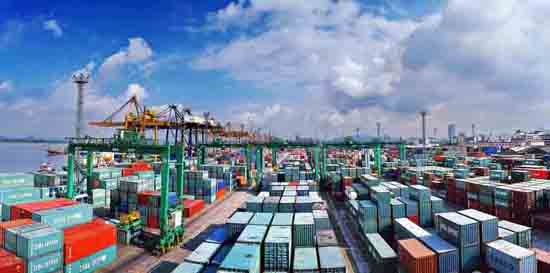

 |
| (File Photo) |
BEIJING, Nov. 8 -- China's foreign trade dropped 9 percent year on year to 2.06 trillion yuan (325 billion U.S. dollars) in October, the eighth consecutive monthly decline.
Exports dropped 3.6 percent to 1.23 trillion yuan and imports plunged 16 percent to 833 billion yuan. The trade surplus surged 40.2 percent to 393 billion yuan, the General Administration of Customs said.
In the first ten months, foreign trade dropped 8.1 percent year on year to 19.93 trillion yuan. They were separated into 11.5 trillion yuan for exports, down 2 percent; and 8.47 trillion yuan for imports, down 15.2 percent. The trade surplus expanded by 75.3 percent to 2.99 trillion yuan.
China reported 2.87 trillion yuan of trade with the European Union, its largest trade partner, in the first ten months, down 7.9 percent year on year; 2.85 trillion yuan with the United States, the second-largest trade partner, up 2.4 percent, according to the GAC data.
Meanwhile, trade with the Association of Southeast Asian Nations, the third-largest trade partner, and the fifth trade partner Japan dropped 2.4 percent and 10.7 percent year on year, to 2.34 trillion yuan and 1.42 trillion yuan respectively.
Foreign trade of private firms dropped 2.8 percent year on year in the first ten months to 7.28 trillion yuan, accounting for about 36.5 percent of China's total exports during the period. But exports of private firms rose 2 percent year on year.
In contrast, state-owned enterprises witnessed a sharper foreign trade fall of 13.2 percent year on year to 3.33 trillion yuan.
HSBC analyst Qu Hongbin attributed the drops mainly to commodity prices, subdued external and internal demand, noting that exports to emerging markets experienced sudden decline.
China exported more mechanical and electrical products while exporting fewer labor-intensive products such as clothing, shoes and textiles in the first ten months.
Exports of mechanical and electrical products climbed 1.4 percent to 6.58 trillion yuan, accounting for about 57.4 percent of the country's total exports in the first ten months.
In contrast, exports of seven traditional labor-intensive products dropped 2.5 percent to 2.41 trillion yuan, accounting for about 21 percent of the total exports in the first ten months. Of these products, clothing exports dropped 7 percent and exports of shoes dropped 4.7 percent.
Heavyweight provinces such as Guangdong, Jiangsu and Zhejiang registered better than average performance, with Guangdong, the country's largest province in terms of foreign trade, dropping by 5.2 percent year on year. Foreign trade declined 3.3 percent year on year in Jiangsu, 2.4 percent in Shanghai and 2.2 percent in Zhejiang.
The State Council has rolled out a series of policies to boost foreign trade, including launching free trade zones and cross-border e-commerce pilot areas.
In July, China's cabinet issued guidelines urging governments at all levels to implement measures to foster imports and exports, as the country strives to open its markets wider and upgrade its economy.
Qu expected more easing efforts in the fourth quarter to ramp up domestic demand and stabilize economic growth.
 Amazing Chinese fighters
Amazing Chinese fighters
 When a Chinese woman marries an Indian man
When a Chinese woman marries an Indian man Love beyond limit of heights in the world
Love beyond limit of heights in the world
 Photos of beautiful teacher hit the Internet
Photos of beautiful teacher hit the Internet Transparent Over-cliff Path Cracked Suddenly
Transparent Over-cliff Path Cracked Suddenly Bride-to-be tries to save drowned man
Bride-to-be tries to save drowned man Russian helicopter lands safely after being attacked in Syria
Russian helicopter lands safely after being attacked in Syria Models change clothes on street in Hangzhou
Models change clothes on street in Hangzhou Winding mountain road
in China
Winding mountain road
in China Top 20 hottest women in the world in 2014
Top 20 hottest women in the world in 2014 Top 10 hardest languages to learn
Top 10 hardest languages to learn 10 Chinese female stars with most beautiful faces
10 Chinese female stars with most beautiful faces China’s Top 10 Unique Bridges, Highways and Roads
China’s Top 10 Unique Bridges, Highways and Roads Women need not apply
Women need not apply Lesson from the blasts
Lesson from the blasts China, Vietnam advance comradely ties
China, Vietnam advance comradely ties Inmate art exhibit draws attention to mental health
Inmate art exhibit draws attention to mental healthDay|Week